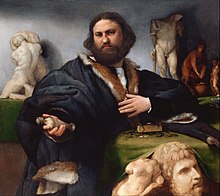

The Reynst Collection, probably the most extensive Dutch 17th-century collection of art and artefacts, was owned by the Dutch merchants Gerrit Reynst (also known as Gerard Reynst) and Jan Reynst. The collection was put on display in their house at the sign of Hope on the Keizersgracht in Amsterdam. It consisted of over 200 Italian paintings and over 300 sculptures, most of them ancient Roman. There were other antiquities: ten sepulchral monuments, five votive reliefs, nine cinerary urns, "Etruscan" vases, and Christian objects, as well as engraved gems. The collection was dispersed in the 1660s and 1670s, after both brothers had died, and Gerrit's widow sold parts to various buyers.[1]
- ^ Anne-Marie S. Logan, The 'Cabinet' of the Brothers Gerard and Jan Reynst (Amsterdam: north-Holland Publishing) 1979. Reviewed by F. L. Bastet in Simiolus: Netherlands Quarterly for the History of Art 11. 1 (1980:55–57).